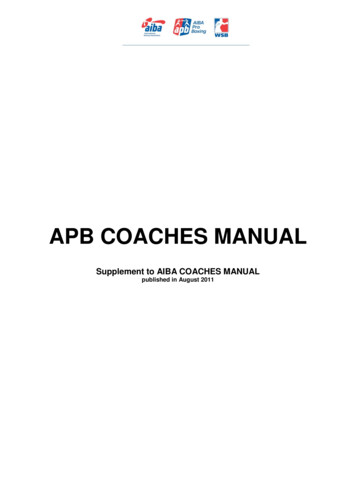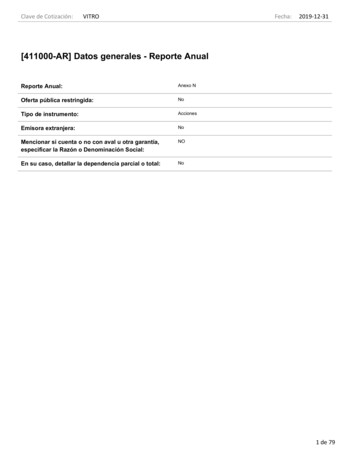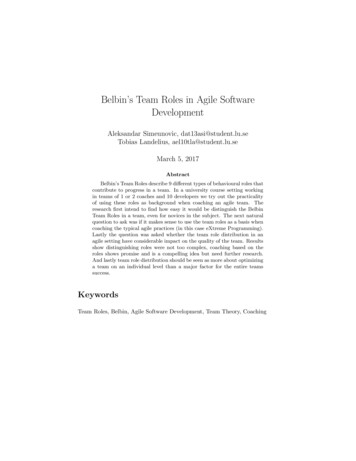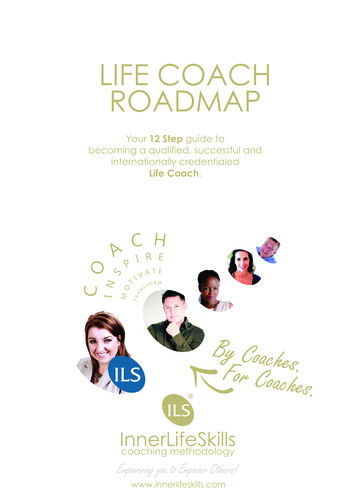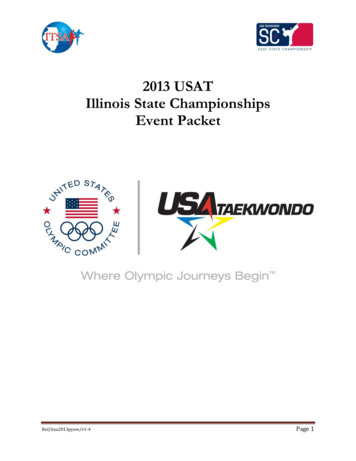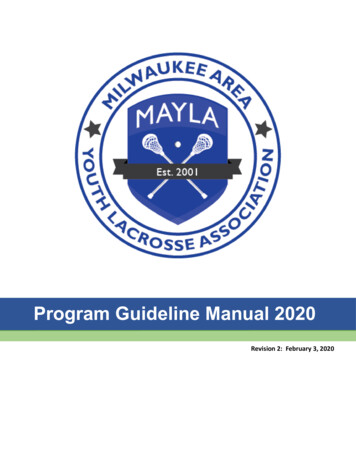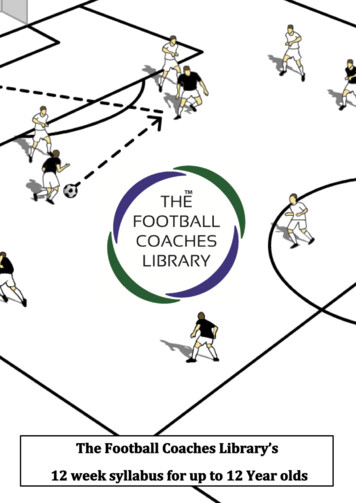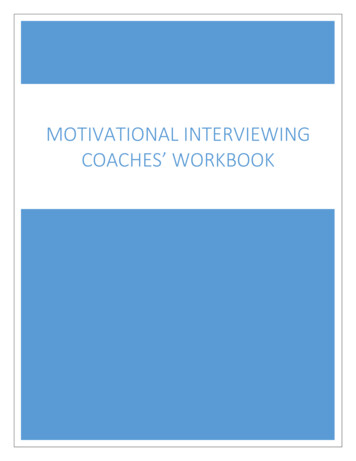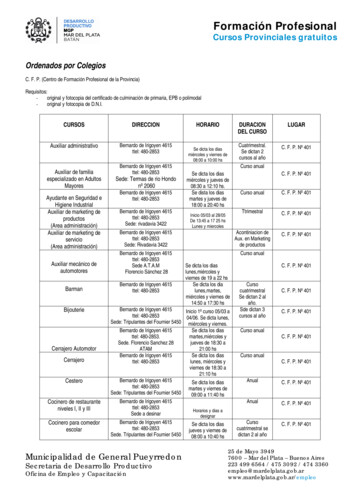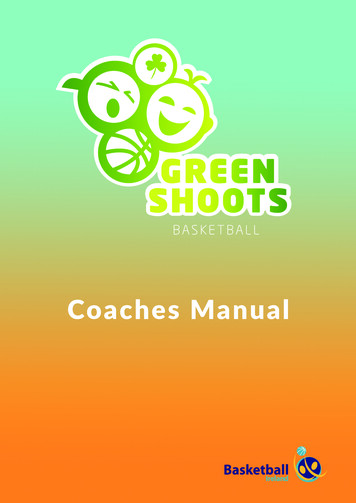
Transcription
CoachesManual
Developing a Coaching PhilosophyA coaching philosophy is a statement of what you value and how you will approach yourcoaching role. It covers your purpose as a coach and how you will approach playerdevelopment and success. Your coaching philosophy consists of your major objectives andthe beliefs and principles that you adhere to in order to achieve your objectives.Identify What is Most Important to YouIt is important to first understand the non-negotiable values within your coaching role. Everycoach has certain things they never compromise on. It is important once you have establishedyour values to identify which are your most critical values. See the bottom section for more ondeveloping your core values.Learn from Your Own ExperiencesBeing a coach is largely about being yourself and this means being authentic. Most coacheslearn from the coaches they had when they were athletes themselves. This aspect of learningfrom your own experiences is something you can bring to your current coaching role. Youshould identify the behaviors, values and the lessons you learnt from different coaches overyour career.1 Page
What is Your Coaching Style?Every coach has a coaching style which is largely defined by their personality and their belief inhow the game of basketball should be played. This coaching style will have strengths andweaknesses. Essentially understanding your coaching style will help you to comprehend yourmotivations, the environment you perform best in, and how you communicate best. Byunderstanding your coaching style, you are better positioned to be able to adapt to differentsituations. I would encourage all coaches to become athlete-centred in their coaching approachby putting the needs and development of your athletes at the centre of your focus.Discover your Coaching PhilosophyThink about the behavior you wish to exhibit consistently, how you wish to conduct yourself,how this behavior will impact on your athletes, and the results of this impact. Now you canbegin to create a framework to govern your conduct in your coaching role and should link towhere you discovered your core values in relation to being a coach.Another aspect to the coaching role and philosophy is how you define success. Defining whattruly is success is often not a simple matter of determining who has more points at the end of agame. Winning, therefore, is only part of the measure of success. You should define yourunique coaching philosophy in a succinct statement- here is an example of one:I am a Coach because of my passion for my work. I am able to foster the growth of my playersthrough the numerous opportunities I am fortunate to provide. I will mold a group of individualsto communicate, to be responsible and to hold themselves accountable. I believe in nurturingtheir dreams to be the best on and off the court.Here is an example of a coaching philosophy:I believe four factors are essential to being successful over the long haul in the coachingprofession:1.2.3.4.An understanding of young people and what motivates them,A commitment to relational mentoring,Expertise in teaching the game of basketball, andA commitment to prepared planning.Level 2:TeachingLevel 1:RelationshipsCore:PreparationandFundamentals2 Page
The core of this philosophy centres around two concepts: preparation and fundamentals. Ibelieve that preparation overcomes any lack of talent and that fundamentals are the buildingblocks of basketball.Level 1 centres around four relational concepts: Role modeling; approachable leadership;relationship building and mentorship; and whole person development.Level 2 includes six teaching components: Game strategy; competitive attitude; discipline;teamwork; persistence; and goal achievement.Mastery of these levels leads to success. I define coaching success as seeing team membersreach their maximum potential, both on and off the court. Winning is important in building astrong program, though it is not the benchmark for success.Keep it Visible and AliveHaving now compiled your values, behaviors, and definitions of success, the final step is to keepthis consolidated work in a place where you can review it regularly and see it every day. Yourcoaching philosophy is something unique to you about who you are and want to be. It isimportant to constantly remind yourself of what your philosophy is.Defining Your Core ValuesSo, how important is it to focus on your core values when developing your coachingphilosophy? It is very important. It truly takes understanding what it means to be a coach, howyou view yourself in your coaching role (whether that be teacher, friend, or mentor), what youhope to accomplish in your coaching career, and what you think makes a coach effective. Corevalues to consider as you look at developing your philosophy could be placing players first,sport leading to development of character in your athletes, having a true love of the game as acoach, developing a positive team and individual environment, how your personality styleimpacts your philosophy as a coach, the teaching of positive decision-making, placing a highvalue on lifelong learning, and placing a high value on the consistent improvement of theirplayers and positive skill development.SummaryOnce you have determined what you want your coaching philosophy to look like, it can behelpful to write it down, and even share it with your players, staff or colleagues, then stick to it.Although you cannot alter your players, you can alter your approach to coaching them, and thatcan make all the difference. While the process of developing a coaching philosophy will helpyou to clarify your values and what is important to you, just having it written down is notenough. Too often coaches write a philosophy statement and then leave it in the drawer. To beeffective, the philosophy needs to be used, which means that you live it day in and day out. This3 Page
also means that you abide by it late in the season, when the pressure is on, as much as you dothe first day of training.Practice planningPractice planning is one of the most important areas of becoming a successful coach. Eachsegment of practice should be planned with the goal of getting the most out of the session. Thisis especially important in Ireland where practice time is limited. Legendary Indiana Universityhead basketball coach Bob Knight said "The structure of your practice is the most determiningreason for your success or lack of success as a coach."Take a look at these principles from legendary UCLA head basketball coach John Wooden,found in the Nater and Gallimore (2006) book, “You Haven’t Taught Until They Have Learned:John Wooden’s Teaching Principles and Practices.” Not only was John Wooden a greatbasketball coach, but also a master teacher:Coach John Wooden’s Eight Principles of Practice Plan Design1. Fundamentals before creativity Basic skills before complex skills (Wooden believed that teaching of fundamentals,until they are all executed quickly, properly, and without conscious thought, isprerequisite to playing the game). Some practice time should be allocated for fundamental motor skills regardless oflevel Wooden once said this: “Drilling created a foundation on which individual initiativeand imagination can flourish.” That is the job of any coach.2. Use variety Although the general skeleton of practice lessons were the same for Wooden eachseason, he would introduce new practice activities frequently to keep thingsinteresting and fun Rearrange order of drills Have themed practices3. Teach new material at start of practice Not in fatigued state mentally or physically; minds and bodies are fresh in the firstpart of training and Wooden could devise activities during the second half ofpractice for the application of new material4 Page
4. Quick transitions between activities Maintain flow- Wooden’s practices had lightning-quick transitions from activity toactivity No time wasted- the best way to keep the players focused is to have constantmovement and change Practical sequence of activities Equipment set-up beforehand5. Increase complexity from practice to practice Progressions (teach various aspects of the game by breaking things down alltogether, then into parts, drill those parts, and then put it all together[whole/part/whole philosophy]). From simple to complex, every movement and every action should be carefullythought out and planned6. Conditioning for learning Not conditioning for the sake of conditioning Wooden’s philosophy was for players and students to improve a little every day andmake perfection a goal Wooden had this demand- each player, when reaching the point of exhaustion, wasto push themselves beyond, leading to top conditioning being attained over time Progressive overload (for improvement to occur, the body must work harder than itis used to. Therefore, the load must be continually and progressively increased tocontinually and progressively achieve results).7. End on positive note Fun games Visualization of correcting a mistake at end of practice8. Avoid altering a plan during the lesson Can disrupt the flow of the session Wooden believed in ending practices on time; this, he believed, would help maintainthe intensity level throughout the session.5 Page
Content of a Practice PlanSuccessful Canadian coach Chris Oliver believes that all effective basketball practices have thesame basic structure. The basic structure forms the beginning, body and conclusion of apractice. Within each of these parts of practice, the basic structure helps a coach plan, organizeand execute a practice plan. A basketball practice can be broken down into three phases1. Pre-Practice Physiological and psychological preparation for the task aheadReduces the risk of injuryOvercomes the body’s inherent lazinessStimulates the Central Nervous System (sport specific movements)Should motivate individuals for upcoming activity2. Principle Content Technical and tactical workDevelopment of the 5 S’s of sport training: Stamina, Speed, Strength, Skill, and SpiritPerformance simulation3. Post-Practice Enhance physical recovery and psychological satisfactionRe-hydration and carbohydrate replenishmentEncourage psychological skills trainingStretchTeam talk and/or individual talksOliver always starts with WHAT to practice and then how. It is important that every drill has apurpose/emphasis and all understand the reason why it is being done. He also believes thatspending proportional amounts of time on things that happen in a game is extremelyimportant. Coaches need to design practice in a way that makes players feel comfortable inreal game situations.Example of a Practice PlanBelow, find an example of a practice plan that I have used in the past with a U16 club teamin Ireland. This is just one example- every coach has different planning philosophies andtemplates, with many different examples being found on the Internet. You can also rea chout to any of the Basketball Ireland Development Officers for assistance. No matter whichone you use, being disciplined to use your time wisely is paramount for your success as acoach.6 Page
U16M Team Practice*practice plan is subject to change based on time 5-6:006:00-6:076:07-6:137 PageI. Introduction.II. Warm-up: Full-court Coleman Drill (good passes, do not let the ball touch theground until near basket- one dribble max; hands ready, move forward fast).III. Dynamic Stretching. Knee Ups (on toes). Quad stretch (right hand to left foot behind, on toes). Kicks Outside In- half court. Kicks Inside Out- half court. Conley’s/“Dancers” (left hand down, right leg back straight). Slide Stretch. Slide Squats. Squeakers. Carioca (Hands Up). Lunges with trunk twist. Butt Kicks- half court. High Knees- half court.IV. Whole Teaching: Shell Drill (4 out, 0 in). Regular. Dribble gap (jab and recover). Dribble out/clear concept. Guard basket cut/interchange backside. Focus on help side and jump to the ball, on the ball stance. Play on “live” call.V. Part teaching: Chair Help Drill (coaches at point and wings). Sprint to closeout and help side. Proper closeout low rear end, chopping feet, hands high, cushion. Yell “skip” and communicate in position you are in (“ball,” “help,” “deny”).VI. Part Teaching: Stance work (discuss trace hand/hand by ear/“push” verbal). UMass Lunge Drill (1, 2).o Teach trace hand via Partner Trace Drill. 1 Minute Laker Zig-Zag Drill.o Must have active hands or we will start over.o Trace hands and ear hand up or we start over.o Fight through fatigue.o Do not turn your back as a handler; get low and strong with theball.o Get down in a stance, proper closeout each time with hands highand butt low.o Yell “Push.”VII. Part Teaching: Rebounding. Quick explanation of positioning (Faceguard positioning, make contact witharm bar, be physical!). Line Check-out Drill – three lines, one ball (hold two seconds). O to D, D toend of line, next in line is O. 4 v. 4 Scramble Rebounding (three teams competitive).
6:526:52-6:576:57-7:008 Pageo Team plays defense, then O to D, D off.o Offensive rebounds count 2 points.o Baskets count one point.o One point for D rebound or stop.o Move in counter-clockwise fashion.VIII. Part Teaching: Closeout Series (Partners). Creep up (ball high)/Back-up (ball low). Creep up/Back-up, Right dribble/Pick-up/ “Ball” call. Creep up/Back-up, Left dribble/Pick-up/ “Ball” call. Creep up/Back-up, Right dribble/Take Charge. Creep up/Back-up, Left dribble/Take Charge.IX. Part Teaching: 2 v. 2 Help/Recover Drill (Two Stations). Three dribble limit. Stop the drive.X. Part Teaching: 2 v. 2 Knock Down the Cutter Drill (Two Stations). Sprint to help and have vision on your man and ball. Try to score if you get the opportunity.XI. Part Teaching: Duke Drill (Two Stations). 1 v. 1 with a coach. Works on all positions played on D individually. Closeout on the ball, jump to the ball, back door to block and back (fliphead/hand), dribble out wing/defend post/“clear” help position/knockdown the cutter, play 1 v. 1.XII. Part Teaching: 3 v. 3 Ranger Drill (continuous). Ball in point defender’s hands. Coach has ball at right wing. Other coach catches ball from driving wing on right side. Will pass to thepoint after first ball is passed to wing. Help rotation, sell out and take charge, help the helper.XIII. Whole Teaching: Spartan Transition Drill. 2 on 1/3 on 2/4 on 3/5 on 4/5 on 5. Defense rebounds, adds two more players, O gets back on D for 3 on 2. On other end, add two more coming back to make 4 on 3. Add two more coming back for 5 on 4. Add last one for 5 on 5. Can be a taxing drill must communicate and point out who you have.XIV. Whole Teaching: Explain Score-Stop Scrimmage 5 v. 5 and play for five minutes. In order to get credit for the basket you just made, you must stop the otherteam from scoring when they have the ball after you score. You cannot foulthe other team when you are on defense. If you commit a foul the basket isnegated. Must make both free throws to get the opportunity to score on defensiveend.XV. Pick me ups, announcements. Positive self-talk (70,000 thoughts a day). Stretch, recover, rehydrate.
1v1 progressionSet-UpPasser (3) at the TOK. Offense (1) is on right block. Defense(2) is on left block. When 3 slaps the ball, both 1and 2 cut out to the wing and it goes to live 1 on1. Offense stays if they score. If defense gets astop they go to offense. Passer goes off andwaiting player comes on to be D. Loser goes topass.Time: 5 minutes a sideScoring: Each made shot is 1-pointObjective: Score the most points in5 minutesConstraints: Offense has 3 dribbles; Offensehas a 1 second decision clock (no shot ordrive within 1 second turnover).Teaching Points (Offense):-Shot/drive preparation on the catchShoot/drive decision makingUse the dribble to go cover groundShoulders lower than D on the driveUse body to protect ball as you finish9 PageTeaching Points (Defense):-Closeouts with high handsCatching the first dribbleWalling up when offense tries to score in the paintBlocking out after a possession
Set-UpAny spots on the court can be used. 1player is offence, the other is defence.Coach or a third player can be thescreener. Offence is trying to score offthe ball screen. Defence is trying toget a stop.Time: Coaches choiceScoring: both 2 point and 3 pointshots are awarded.Objective: Score the most points in 5minutesTeaching Points (Offensive):- Ball screen set-up- On ball offensive reads- Feel your defender- Pace and deception10 P a g eTeaching Points (Defensive):- On-ball defence with ball screen- Getting skinny over a screen- On-ball stance and position
Set-UpOne player on offence, another on defencebeginning in the far paint. Cones are set up to makea small area to play 1v1. The defence must forcethe offensive player to change direction as theyadvance down the court. 1 point for a score and 1point for a stop, first to 5 points wins.Teaching Points (Offensive):- Stay low in an athletic stance- Use a variety of moves to avoid losing possession- Force the defender to change directionTeaching Points (Defensive):- Stay low in an athletic stance- Force the offensive player to change direction- Put pressure on the offensive player withoutcommitting a foulSet-upX1 will pass the basketball to 1, 1 will dribblearound the cone and attack the basket.Immediately after passing the ball, x1 willsprint around the cone and meet 1 in thepaint to challenge the shot.Some examples of finishes to use could be:- 2 foot lay-up- 2 foot up and under- Pound and slide by- Pound and slide by up and under11 P a g e
Set up:On the coach’s whistle, 1 dribbles aroundthe cone and 2 sprints to touch the conein the short corner. After that it is live1v1.Constraints:3 dribbles or less after the coneOnly rim finishesOnly one change of direction moveallowedOnly score in the paintSet up:Can use any type of screen that you choose:-Wide pin down- Narrow pin down (shown)- Flare screen- Baseline out screenDefense can guard any way they like.Offense only has 2 dribbles off the screento score. Emphasis is on reading thedefender and making a split-seconddecision.12 P a g eCOACH
2 34Set up:Coach throws ahead to 1. As 1 crosses halfcourt, 2 sprints out to defend. Whoeverwins the possession (offense score, getsfouled or offensive rebound, defensivestop or rebound) keeps going.This drill can be adapted to play 2v2.13 P a g e34
ReboundingSteve Nash Youth Basketball Coaching Manual explains that “The focus of rebounding for young playersshould be on creating a desire for the basketball.” Players must understand that they can be an effectiverebounder regardless of size or speed. In order to be an effective rebounder, the player must want to bea good rebounder. Rebounding involves all five players on a team, without this the opposing team arelikely to retrieve the ball.Every player is a potential rebounder and must work to neutralize their opponent to gather the ball.Every shot is a potential rebound and this starts as soon as the ball leaves the shooters hand. Thedefensive player must make contact with their counterpart and slow/stop their forward momentum tothe rim. If contact cannot be made the defensive player must impede the offensive players path.Once a player has retrieved the ball, he/she must be strong and not bring it down low to avoid it gettingsnatched. It is important to teach the following Keep the ball high. Immediately turn to survey the floor. Outlet the ball as quickly as possible in order to start the fast break.Remember, rebounding is an attitude and is a matter of desire, aggressiveness, awareness andconsistency.Set up:Three lines line up around the key. The first person in eachline is the defensive player. The second player in each line isthe offensive player.Once the ball is shot there is a scramble to retrieve the ball.The defensive team should stay in place until they securethree rebounds.14 P a g e
3X3 Rules of the GamesCourt and Ball:A half court with a standard basket can be used for 3x3.An official 3x3 should be used where possible, if this is not available a size 6 ball should be usedfor all competition.Team Roster:3 players 1 substitute.The game must start with 3 players on the court for each team.Referee(s):1 or two referees can be used.3x3 is also ideal for players to run themselves without the need for a referee.Time-outs:1 per team for 30 seconds.FIBA rules allow for two TV time-outs, at first dead ball after 6:59 and 3:59.Initial possession:The initial possession is decided by coin flip.Possession following a successful goal:Defence gains possession right under the hoop, inside the no-charge circle.Ball must clear the arc by passing or dribbling.Defensive team cannot to attempt to steal the ball inside the no-charge circle after a score.A new shot clock starts when a team gathers passion of the ball.Change of possession:The ball must clear the 3-point line when there is a change of possession.Scoring:1 point for score inside the arc and 2 points for a score outside the arc.Game duration and Score Limit:1 x 10 minutes, playing time.Score limit: 21 pointsOvertime:First team to 2 points.Free throw(s) following a shooting foul:1 free throw.2 free throws, if foul committed behind arc.15 P a g e
Combining Multiple Skills in DrillsOne of the biggest challenges for coaches in Ireland is the limited amount of time provided fortraining each week. Time constraints can affect the player’s fundamentals and put a majorstrain on coaches. This is a challenge across Ireland, so coaches must make the most out of thetime they have with their team.One effective way to teach fundamentals is to develop drills that incorporate multipleskills. Instead of having one ball-handling drill, then another passing drill, and then anothershooting drill try to combine those skills into one drill. You can get the same repetition of skillsbut spend less practice time. It will allow you more time to spend on other aspects of the gameto prepare your team.Here is a great example of one drill that can be used for man-to-man defense and coversmultiple defensive skills/situations- it is called Duke Seven-Point Defensive Drill. This is a oneon-one drill with a coach as the passer and dribbler. It covers the following points:1.2.3.4.5.6.7.Close-out (from the block with defender passing the ball to the wing player)Wing passes to Coach at Point- Jump to the ball and denyJab and Recover on Coach’s drive into the gapDenial and defend the backdoor cutPost defense for a two-countHelp side defensive positioningEither one of two scenarios:a. Closeout on skip pass to your man (out of help side position) from coach onopposite wing; play one-on-one, offensive player gets three dribbles max.b. Denial of a flash cut by opposite wing offensive player; defender knocks downcutter, coach passes to offensive player. Play one-on-one, offensive player getsthree dribbles max.As you see in this example, this covers every defensive skill needed in one drill. However, it isimportant to understand that the separate skills must be taught and drilled first beforecombining them into one drill. It is best to first teach the skills separate then when you feelthey know how to perform each skill then start to combine them into one drill. Any of theBasketball Ireland Development Officers can offer excellent ideas for drills for progressionto combine multiple skills in drills. It will make a huge difference in being an efficient teacher ofthe game.16 P a g e
Strength and ConditioningReasoning Behind Long Term Athletic Development (LTAD) Planning: It is hard to “catch up” on basic physical competencies after 19 – 21 years of ageThe same model for “Strength” can be designed to incorporate Speed and Powertraining with specific criteria necessary for each youth athlete to move through thestages safely and effectivelyResistance training is safe for children and youth if:1.Program is well designed (appropriate to child’s age and capabilities)2.Very well coached and supervisedThe objectives of resistance training for youth –o Improve body and limb controlo Improve joint stabilityo Improve strength enduranceo Decrease the long term risk of serious, chronic and re-occurring injurieso Improving these factors lays the foundations for improved maximal strength,power or sports performance in the latter years and also in the immediatetermSpeed and AgilityLinear AccelerationBlock 1 (Posture and Actions):Wall Drills (Can use astro partitions or fences)1.2.3.17 P a g eWall Lean Pistons (Single Leg) (2 sets of 10) – 1 leg in triple extension and the otherin triple flexion. On call (cue), the athlete will drive the fully flexed leg into tripleextension in an explosive mannerReverse Wall Lean Pistons (Single leg) (2 sets of 10) – both feet start on the groundwith the athlete leaning against a surface, hands kept in line with shoulder. Athletewill be on the toes so that all three joints (ankle, knee and hip are all in extension[straight]). On cue, the athlete will drive on leg up as if starting a sprinting motion –simulating exploding out of the blocks.Static Arm Accelerations (2 sets of 10 each arm) – start off in a staggered stance.Start off with elbows at 900 angle and the starting position should be with the armon the same side of the forward most leg in the staggered stance should also be inthe forward position. The opposite side should have both the leg and arm backbehind the torso. When cued (on go), the athlete should aggressive drive the arms inopposite directions (again simulating coming out of the blocks). The athlete shouldthen return arms to starting position to perform multiple reps.
Lateral Shuffle AccelerationBlock 1 (Shuffle Acceleration):1.2.3.Lateral Shuffle: One Step Power Push Off (2 sets of 5 reps) – feet wider then ourshoulders and feet facing straight ahead. Drive the knees forward and hips backwhile keeping the heels down. Push down and away when moving laterally. Lift thefoot of the direction you are going while turning the toe in that direction. Stay in thetunnel: meaning that you stay down when pushing off – not standing up tall eachtime.Lateral Shuffle: Two Steps (2 sets of 3 each side) – For more than one step, leadfoot turns out and drags with the foot facing the direction the athlete is travelling.Stay in the tunnel.Lateral Shuffle Run Off (8 yard shuffle / 1 set each side) – push down and away, letthe lead leg help you recover and drag through and stay in the tunnel are 3important coaching cues with the lateral shuffle. For the shuffle run out use adistance between the cones of about 20 yards.Crossover Acceleration“The King of Athletic Movement”Block 1 (Crossover Acceleration):1.2.3.18 P a g eCrossover Directional Step, Directional Step Push Off (2 sets of 5 reps) – start with adirectional step by opening up the hip of the side you are shuffling to. Backside footpushes off, crossing the backside leg over the front, turning the body over intosprinting in that direction. 1 step to gain skill.Crossover Directional Step, 2 Crossovers (2 sets of 3 each side) – same as crossoverdirectional step.Crossover Run Off (10 YD Speed Crossover / 1 set of 5 each side) – try and keep theupper body square to where the side where you started and not square to thedirection you are running. Disassociation of upper and lower body is important
Retreating SkillsHighly Important Skills for Teaching Athletes to React and Move When a Play Breaks DownBlock 1 (Backpedal):1.2.3.Alternate Short 3 Step Backpedal (1 – 2 sets of 20 Yards) – separate cones 20 yardsapart. Athlete starts low in a power stance with nose just above the toes. 1 bigbackpedal followed by 3 short choppy steps – strong push – off backwards but don’textend the stride to the point where the athlete is no longer in an athletic position.Need to be in a position to react to the ball!!!!10 Yard Backpedal (2 sets of 3 – 5) – stay low with shorter choppy arm actionbecause of the shorter stepping action.Resisted 5 – 8 Yard Backpedal (2 sets of 3 – 5) – band around the athletes’ hips andcoach must get low to keep the band around the athletes’ hips. Less resistance forthe younger athletes – adjust tension to coincide with strength levels.Power DevelopmentGoing to look at landing mechanics for all drills – firstBlock 1 (Parallel Stance):1. Toe Drops (1 x 10) – have the athlete start up tall and on the toes and drop quickly intostrong landing position with hips back, heels down, chest tall and arms up ready to catchand receive the ball.2. Chair jumps: Clusters (5 sets of single reps) – start by sitting the athlete into the chairwith heels down on the ground, leaning forward get the athlete to jump from the seatedposition and land in the same strong position as with the earlier sets3. Toe Drop Verticals (2 – 5 sets of 5 reps: break for a second between each of the reps) –same as toe drop only the athlete performs vertical jump after heels drop down andthen try to land again with hips back, heels down and chest tall4. Repeat Vertical (multiple toe drop verticals) (2 – 5 sets of 3 reps) – start with the toedrop but then perform 3 consecutive jumpsAgility Drills (Do after performing speed work)Go from simple drills to more complex. Go form closed (where the athlete is fully aware of thetask) to open (where the athlete knows what’s involved but drill has different elements –different coloured cones that any of which may be called upon).19 P a g e
Movement OnlyT-DrillBox DrillIllinois DrillPro-Agility DrillBall IntegratedColour Cone Zig Zag DrillColour and Numbered ConesTeams can line up beside each or facing each other. Run to a marker a perform stutter steps onthe toes. Then call out the cones according to colour. Switch the cones up and ass number
John Wooden's Teaching Principles and Practices." Not only was John Wooden a great basketball coach, but also a master teacher: Coach John Wooden's Eight Principles of Practice Plan Design 1. Fundamentals before creativity Basic skills before complex skills (Wooden believed that teaching of fundamentals,
